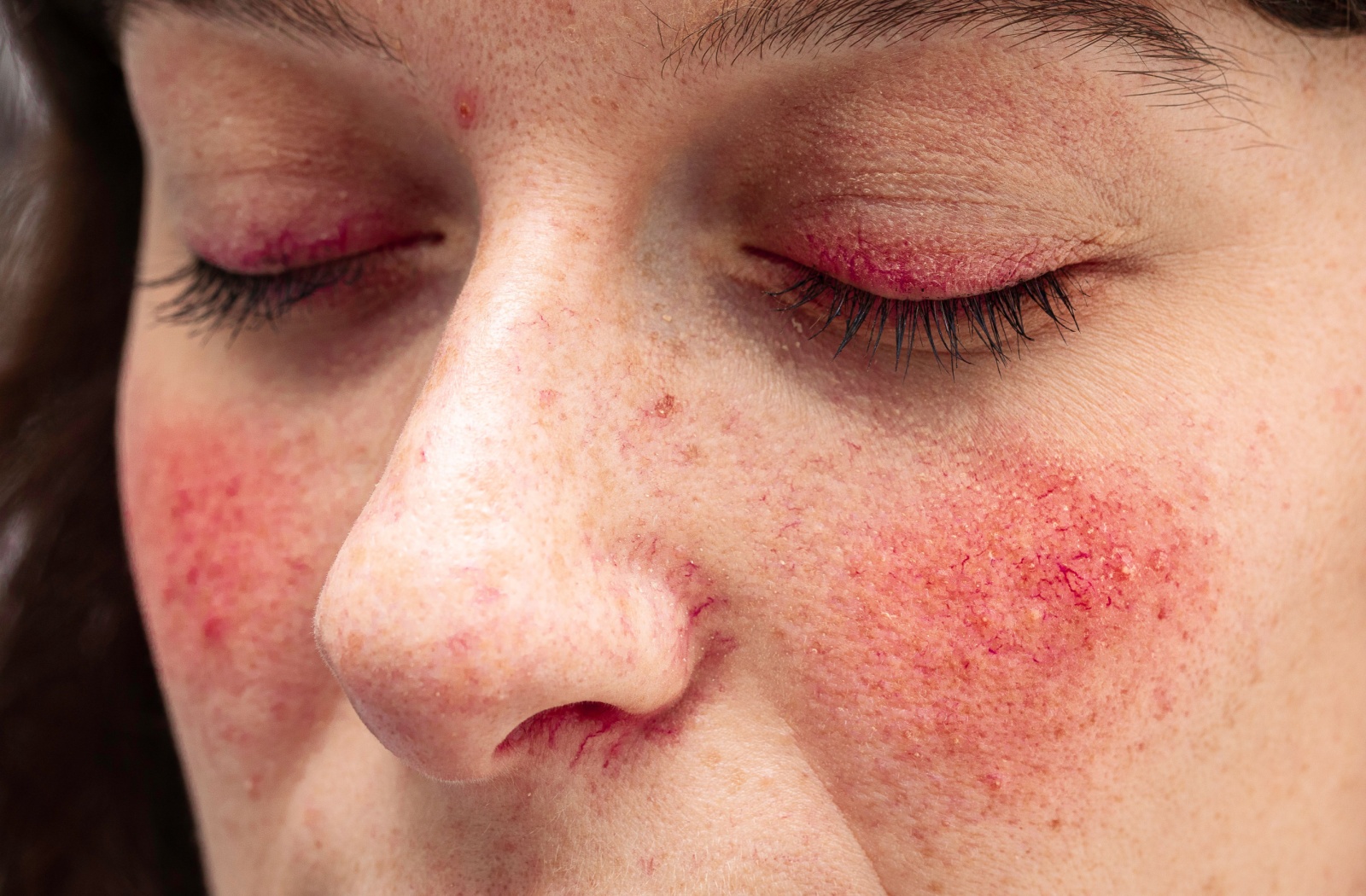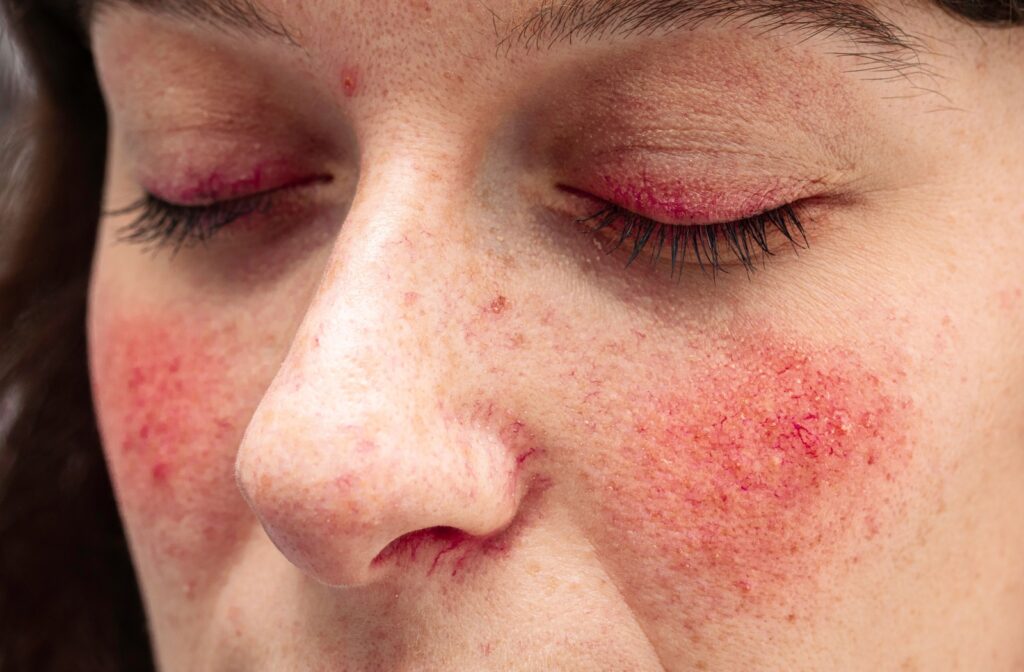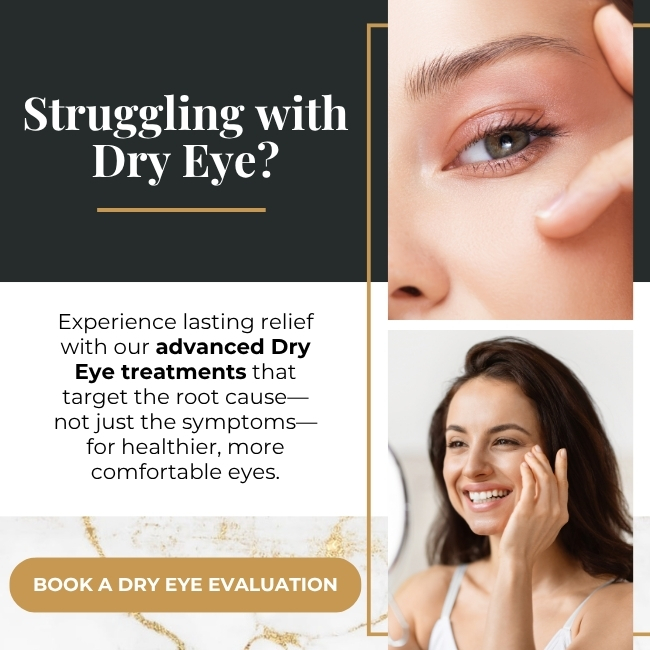Ocular rosacea affects many people, yet it remains a relatively unknown condition. It can be a perplexing and frustrating condition that takes time, patience, and a comprehensive approach to treat and manage.
There’s no cure for ocular rosacea which would completely get rid of it, but you can take steps and there are treatments to control this condition, prevent flare-ups and stop its progression. Ultimately, these treatments will maintain and preserve your ocular health.
Understanding Ocular Rosacea
Ocular rosacea primarily affects the eyes, causing symptoms such as redness, dryness, irritation, itching, and a gritty or burning sensation. It can also lead to light sensitivity and, in severe cases, vision problems. Just like facial rosacea, which is characterized by visible redness, bumps, and pustules on the skin, ocular rosacea are the same signs explicitly in the eyes and eyelids.
The condition can range from mild to severe. Some people with ocular rosacea also have facial rosacea, and vice versa, but having one doesn’t mean that you’ll get the other.
The causes of ocular rosacea are still not fully understood, though factors like genetics, inflammation, and environmental triggers are all thought to play a role. Let’s have a closer look at what a person’s experience with ocular rosacea might look like.
My Journey with Ocular Rosacea
Like many others, I didn’t know I had ocular rosacea at first.
My symptoms started subtly—my eyes would feel dry and scratchy, as if I had something in them. I noticed constant redness around my eyes. At times, I felt a burning sensation that worsened throughout the day. It wasn’t until I began experiencing light sensitivity and frequent eye irritation that I realized something was wrong.
I was diagnosed with ocular rosacea after visiting my eye doctor and undergoing an eye exam. The diagnosis didn’t come as a relief—it was a frustrating and overwhelming experience. I worried about how this condition would affect my daily life and whether it would interfere with my vision.
At the time, I also felt isolated, unsure of how common the condition was or what I could do to alleviate my symptoms.
The Treatment Plan That Worked for Me
Step 1: Medical Consultation & Diagnosis
The first step in my journey was seeking medical advice. While an optometrist or ophthalmologist often diagnoses ocular rosacea, some dermatologists also specialize in the condition. It’s important to see a healthcare professional who understands the nuances of ocular rosacea. My doctor conducted a thorough exam, which included testing for inflammation and assessing my symptoms.
My optometrist also explained that ocular rosacea could be managed and treated with skin treatments, medication and/or lifestyle adjustments. I was relieved to know that, with the right treatment plan, I could control the symptoms.
Step 2: Prescribed Treatments
The next step in my treatment was to treat the underlying causes of ocular rosacea – the inflammation in the skin. Using Intense Pulsed Light (IPL) to eliminate the inflammation in the eyelid and face to stop the root cause of ocular rosacea and provide relief.
In addition to IPL treatments, my optometrist recommended avoiding triggers which cause my rosacea to flare. Things like alcohol, spicy food, and/or excessive sun exposure. I was placed on a skin regimen and a regimen of warm compresses and eyelid scrubs to help remove debris and bacteria from my eyelid margins. These steps were effective in reducing the inflammation and discomfort I was experiencing.
Step 3: Lifestyle & Home Remedies
In addition to these medical treatments, I also made several lifestyle changes that helped support my recovery. One of the most important changes was incorporating daily eyelid hygiene into my routine. I used warm compresses for 5-10 minutes each morning, followed by gently cleaning my eyelids with a cotton pad and eyelid scrub solution. This helped remove any buildup of oils and debris, which can trigger flare-ups.
I also began using supplemental lubricating eye drops throughout the day to keep my eyes moist and reduce dryness. This was helpful until we were able to treat the rosacea (inflammation) with IPL.
I avoided known triggers, such as spicy foods, alcohol, and sun, all of which can worsen rosacea symptoms. Identifying and eliminating my triggers made a noticeable difference in how I felt on a daily basis.
Step 4: Skin Care Regimen
A key part of my treatment was being especially careful with my skincare. My optometrist started me on a botanical, gentle, fragrance-free facial cleanser and avoiding harsh exfoliants. I also prescribed mineral sunscreen which physically blocks UV (ingredients such as zinc oxide and titanium dioxide) and prevents my rosacea from flaring up and getting worse. I use soothing, hydrating eye creams around my eyes to keep the skin nourished and moisturized. With these adjustments, I noticed that the skin around my eyes became less inflamed and irritated, which consequently, improved my ocular symptoms and eye comfort.
Lifestyle Changes That Contributed to Healing
In addition to the direct treatments for ocular rosacea, certain lifestyle changes were essential to my healing process.
One of the common triggers of rosacea is stress. So I started practicing mindfulness meditation and yoga to help keep my stress levels in check.
I also adjusted my diet to include more omega-3-rich foods, like fish and flaxseeds, which are known for their anti-inflammatory properties and may help with ocular rosacea.
Getting enough sleep and staying hydrated were also vital for my recovery. I noticed that, when I wasn’t well-rested, my symptoms worsened, so I prioritized sleep and drank plenty of water throughout the day.
The Results: How I Manage My Ocular Rosacea
After several months of consistent treatments and lifestyle changes, I began to notice significant improvements. My eyes felt less dry and irritated, and the redness around my eyes gradually faded. The burning and gritty sensation became less frequent, and I could go about my day without constantly worrying about my symptoms.
The combination of medical treatment, lifestyle adjustments, and diligent eye care ultimately helped me manage and, in many ways, “cure” my ocular rosacea. I still follow the same routine to maintain my eye health and prevent flare-ups, but I feel confident that I have control over the condition.
Visit Luminance Vision Today
If you’re struggling with ocular rosacea, don’t lose hope. You can manage and even overcome this condition with patience, persistence, and the right treatment plan.
Our team at LUMINANCE VISION is here to help formulate a treatment plan for your specific condition. Visit us our clinic today to see what treatment plan is right for you.




